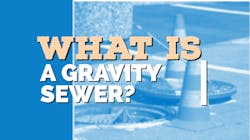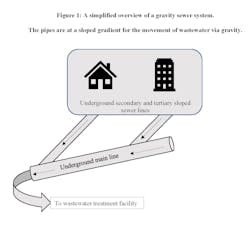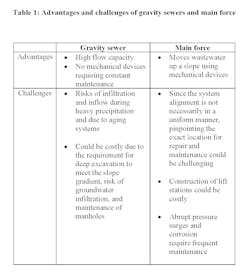Gravity sewer systems are a network of underground pipes that use gravity to move raw wastewater to a regional wastewater treatment plant. The wastewater can consist of black water, gray water, and stormwater.
This article discusses how the gravity sewer system works, how it is different from a force main, and the technical challenges associated with it.
How does a gravity sewer system work?
Figure 1 below is a simplified overview of how a gravity sewer system works. The underground pipes slope downward and away from the source. The downward slope causes the wastewater to flow freely down the pipes due to gravity.
The three types of sewer lines in a gravity sewer system
A conventional system, usually found in urban areas, has branches (secondary and tertiary networks) feeding into the primary (main sewer) line.
The main line runs through the center of the system. Connected to it are the branch lines, collectively made of the secondary and tertiary networks containing wastewater originating from the neighborhood and the housing levels.
Black and grey water – what is the difference?
A gravity sewer contains black and grey water that could be mixed with stormwater (if the system is a combined sewer). While both black and grey water originate from residential areas, black water contains fecal matter from bathrooms and grease from sinks. It is also called sewage or brown water and it contains pathogens. Grey water originates from washing machines and other similar industrial users, and contains a lower level of contamination than black water.
Utility maintenance holes
Utility maintenance holes (also known as sewer access utility maintenance holes or manholes), are located above the sewers and used for routine inspection and cleaning of the sewers. They require periodic maintenance.
Operational factors
A gravity sewer system works due to the downward-sloped pipes carrying the wastewater away from the source due to gravity. There are several factors to consider for ensuring the flow of water in a gravity sewer system. These factors include self-cleansing velocity, downhill gradient, and pipe material and diameter.
Self-cleansing velocity
In general, this is the flow of wastewater that will prevent particles from settling within the pipe. This velocity is typically 0.6 to 0.9 meters per second during peak dry weather conditions — i.e. when precipitation (rainfall and melting ice) is the lowest.
Specifically, the self-cleansing velocity is the minimum velocity of flow at which the suspended solid particles present in the wastewater will not settle and at which scour (clean-off) of the already-deposited particles will occur so that the sewer pipe is kept clean.
The self-cleansing velocity depends on the design of the gravity sewer, the size of the suspended solid particles, the tractive force per unit area, and also on the frictional resistance and effective weight of the sediment particles.
The design of a gravity sewer plays an important role in maintaining the self-cleansing velocity, because the quantity of the wastewater flow fluctuates seasonally.
Minimum flow occurs during the dry season when daily precipitation is the lowest. During minimal flow periods, the flow velocity could be less than the self-cleansing velocity. In this scenario, it is necessary that the gravity sewer system design allows for a continuous flow of the wastewater for scouring.
Downhill gradient
A constant downhill gradient is also required to maintain a self-cleansing velocity and, for this, deep excavation could be necessary during installation.
If the required excavation depth is not possible to attain the necessary downhill gradient, due to the local topography or a higher-level groundwater table, then a pumping station is a possible solution.
Pipe material and diameter
The projected average and peak flows of the wastewater are factors considered when determining the suitable diameter of the pipes. The pipes are commonly made of concrete, PVC, ductile, or cast iron.
Gravity sewers carry raw wastewater containing solids of varying sizes. To prevent the suspended solids from settling (which also depends on the cleansing velocity), the sewer pipes are usually 6 inches, 8 inches, or larger in diameter.
The performance of a gravity sewer system is also affected by its physical and chemical surroundings. While some of these physical factors are identified and discussed above, there are also other factors such as the health of the septic tank.
A septic tank receives raw black and grey water from the source it is connected to, and it removes most suspended solids before the wastewater flows into the gravity sewer. In this way, a septic tank can support the gravity sewer system because it minimizes the quantity and thus the deposition of suspended solids in the sewer lines.
However, a malfunctioning septic tank is not only ineffective in removing suspended solids, it can also lead to the build-up of hydrogen sulfide and other gases and the odor can travel to the gravity sewers. This could cause corrosion in pipes.
In summary, the physical and chemical surroundings affect the gravity sewers. These need to be considered when evaluating the overall performance and when identifying ways to improve the performance of gravity sewers. This will ensure a normal flow of wastewater and its constituents to the wastewater treatment plants.
Pumping alternatives
When deep excavation is a concern, due to factors including poor soil conditions and the water table level, small diameter gravity sewer systems (SDGSs) could be an option.
These are the same as gravity sewers except that they have a smaller diameter usually of 3 inches and flexibility in slope gradient that requires smaller excavation depths. Pressure sewers, vacuum sewers, and force mains are pumping alternatives to gravity sewers.
Pressure sewer and vacuum sewer
In a pressure sewer, the liquid waste is pumped via a high pressure pump in the sewer lines. In a vacuum sewer, a differential pressure for a vacuum environment, via a vacuum pump, is created for sewage flow. The valve in a vacuum sewer separates atmospheric pressure from the vacuum in the pipes.
When the valve opens, the sewage goes through, and then the valve closes. The vacuum pump maintains the vacuum environment in the zig-zag layout of the pipes. In this layout, the slug from the sewage remains and breaks down while the liquid flows forward.
Vacuum sewage systems, patented in the United States since 1888, are more commonly used for small wastewater treatment systems and have higher maintenance costs than gravity sewer systems due to the pumping operation. If the valve fails, the vacuum environment fails.
Force main
Force main sewers are used in areas where gravity sewers are not possible and/or it is necessary for the wastewater flow to overcome gravity. A force main sewer moves wastewater via a pump that carries the wastewater over the topographic height or propels it to where it can continuously flow through the sewer system to the wastewater treatment plant. In lieu of a pump, a pneumatic ejector or a compressor could be used in a lift station to move the water from a low to a higher point.
There are two key elements to a force main: pressure surge control devices (including valves), and a cleaning system.
The diameter and the wall thickness of the pipes in the force main system are determined by the minimum flow rate of the wastewater, the operating pressure, and also by the trench conditions. Force main pipes are commonly made from ductile iron, PVC, and polyethylene. Ductile iron, due to its high strength, can handle high flow capacity while PVC and polyethylene-lined ductile iron pipes have anti-corrosion properties.
The pressure-surge control devices located on the pipes keep the pressure in the system to within a safe range during and after the pump operation. These devices include cone- or ball-type valves that automatically control the pressure surges.
Several insertion and retrieval stations could be located in long force mains and, in some cases, within the lift stations to facilitate the cleaning of the pipes. These stations are equipped with a device that run through the line for cleaning.
Differences from a force main sewer
While gravity sewers do not require mechanical devices and the wastewater flow is by gravity due to the downward sloped pipes, their construction could be costly due to the need for deep excavation and also the need to maintain utility maintenance holes.
The maintenance for main force sewers, although they do not need deep excavation, could be challenging if the system is not aligned uniformly. The exact location for repair and maintenance might not easily be located unless additional technologies are used.
Force mains require frequent maintenance due to abrupt pressure surges and corrosion caused by the gases in the wastewater. The wastewater from septic tanks and in the lift stations of the force main system has a low concentration of oxygen or lacks it entirely. It often contains sulfurous gases that cause corrosion, as well.
In all, gravity sewers and force main sewers each have their share of advantages and disadvantages, which are outlined in Table 1 below.
State regulations on gravity sewers
Different aspects of gravity sewers are regulated depending on the states. For example:
- The North Carolina Department of Environment and Natural Resources covers the minimum design criteria required for permits pertaining to gravity sewers. These include the minimum slope gradient and velocity calculations based on the Manning’s equation. The hydraulic radius is a part of this equation.
- While design standards are also specified for sewer systems in Mendocino City, California,, the California State Water Resources Control Board adopted general discharge requirements for sanitary sewer systems (domestic wastewater originating from sinks and toilets) that will go into effect in June 2023.
A gravity sewer system is one of the major wastewater flow systems delivering wastewater to the local municipal wastewater treatment plant. With a fairly simple design, gravity sewer systems are traditionally well-understood and their maintenance and upkeep is also easier compared to other wastewater flow systems.
Recommended reading on gravity sewers
About the Author
Saleha Kuzniewski
Saleha Kuzniewski, Ph.D. has authored several publications in the fields of scientific research, biotechnology, and environmental regulations. She is the winner of the 2023 Apex award for publication excellence. She is also the founder of Environmental Remediation & Innovations, LLC. Kuzniewski can be reached at [email protected].



